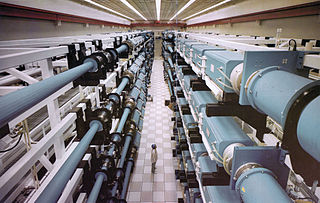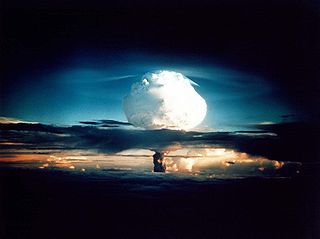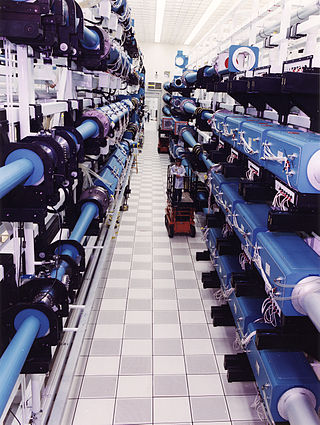Related Research Articles

Cold fusion is a hypothesized type of nuclear reaction that would occur at, or near, room temperature. It would contrast starkly with the "hot" fusion that is known to take place naturally within stars and artificially in hydrogen bombs and prototype fusion reactors under immense pressure and at temperatures of millions of degrees, and be distinguished from muon-catalyzed fusion. There is currently no accepted theoretical model that would allow cold fusion to occur.
Lawrence Livermore National Laboratory (LLNL) is a federally funded research and development center in Livermore, California, United States. Originally established in 1952, the laboratory now is sponsored by the United States Department of Energy and administered by Lawrence Livermore National Security, LLC.

Inertial confinement fusion (ICF) is a fusion energy process that initiates nuclear fusion reactions by compressing and heating targets filled with fuel. The targets are small pellets, typically containing deuterium (2H) and tritium (3H).

Fusion power is a proposed form of power generation that would generate electricity by using heat from nuclear fusion reactions. In a fusion process, two lighter atomic nuclei combine to form a heavier nucleus, while releasing energy. Devices designed to harness this energy are known as fusion reactors. Research into fusion reactors began in the 1940s, but as of 2023, no device has reached net power.
This timeline of nuclear fusion is an incomplete chronological summary of significant events in the study and use of nuclear fusion.

The National Ignition Facility (NIF) is a laser-based inertial confinement fusion (ICF) research device, located at Lawrence Livermore National Laboratory in Livermore, California, United States. NIF's mission is to achieve fusion ignition with high energy gain. It achieved the first instance of scientific breakeven controlled fusion in an experiment on December 5, 2022, with an energy gain factor of 1.5. It supports nuclear weapon maintenance and design by studying the behavior of matter under the conditions found within nuclear explosions.

A fusion energy gain factor, usually expressed with the symbol Q, is the ratio of fusion power produced in a nuclear fusion reactor to the power required to maintain the plasma in steady state. The condition of Q = 1, when the power being released by the fusion reactions is equal to the required heating power, is referred to as breakeven, or in some sources, scientific breakeven.

Nova was a high-power laser built at the Lawrence Livermore National Laboratory (LLNL) in California, United States, in 1984 which conducted advanced inertial confinement fusion (ICF) experiments until its dismantling in 1999. Nova was the first ICF experiment built with the intention of reaching "ignition", a chain reaction of nuclear fusion that releases a large amount of energy. Although Nova failed in this goal, the data it generated clearly defined the problem as being mostly a result of Rayleigh–Taylor instability, leading to the design of the National Ignition Facility, Nova's successor. Nova also generated considerable amounts of data on high-density matter physics, regardless of the lack of ignition, which is useful both in fusion power and nuclear weapons research.

Project Excalibur was a Lawrence Livermore National Laboratory (LLNL) Cold War–era research program to develop an X-ray laser system as a ballistic missile defense (BMD) for the United States. The concept involved packing large numbers of expendable X-ray lasers around a nuclear device, which would orbit in space. During an attack, the device would be detonated, with the X-rays released focused by each laser to destroy multiple incoming target missiles. Because the system would be deployed above the Earth's atmosphere, the X-rays could reach missiles thousands of kilometers away, providing protection over a wide area.

Inertial Fusion Energy is a proposed approach to building a nuclear fusion power plant based on performing inertial confinement fusion at industrial scale. This approach to fusion power is still in a research phase. ICF first developed shortly after the development of the laser in 1960, but was a classified US research program during its earliest years. In 1972, John Nuckolls wrote a paper predicting that compressing a target could create conditions where fusion reactions are chained together, a process known as fusion ignition or a burning plasma. On August 8, 2021, the NIF at Livermore National Laboratory became the first ICF facility in the world to demonstrate this. This breakthrough drove the US Department of Energy to create an Inertial Fusion Energy program in 2022 with a budget of 3 million dollars in its first year.
Fusion ignition is the point at which a nuclear fusion reaction becomes self-sustaining. This occurs when the energy being given off by the reaction heats the fuel mass more rapidly than it cools. In other words, fusion ignition is the point at which the increasing self-heating of the nuclear fusion removes the need for external heating. This is quantified by the Lawson criterion. Ignition can also be defined by the fusion energy gain factor.

LIFE, short for Laser Inertial Fusion Energy, was a fusion energy effort run at Lawrence Livermore National Laboratory between 2008 and 2013. LIFE aimed to develop the technologies necessary to convert the laser-driven inertial confinement fusion concept being developed in the National Ignition Facility (NIF) into a practical commercial power plant, a concept known generally as inertial fusion energy (IFE). LIFE used the same basic concepts as NIF, but aimed to lower costs using mass-produced fuel elements, simplified maintenance, and diode lasers with higher electrical efficiency.
John Hopkin Nuckolls is an American physicist who worked his entire career at the Lawrence Livermore National Laboratory. He is best known for the development of inertial confinement fusion, which is a major branch of fusion power research to this day. He was also the lab's director from 1988 until 1994, when he resigned to become an associate director at large. He was awarded the Ernest Orlando Lawrence Award in 1969, the James Clerk Maxwell Prize for Plasma Physics in 1981 and the Edward Teller Award in 1991.
Dmitri Dmitriyevich Ryutov is a Russian theoretical plasma physicist.
John D. Lindl is an American physicist who specializes in inertial confinement fusion (ICF). He is currently the chief scientist of the National Ignition Facility at the Lawrence Livermore National Laboratory.
David Attwood is an American physicist and professor emeritus at the University of California, Berkeley, where he worked in the field of synchrotron radiation and free-electron lasers, developing X-ray microscopy techniques for research and for the industry. He is the author of a reference book on soft X-rays and extreme ultraviolet radiation.
The history of nuclear fusion began early in the 20th century as an inquiry into how stars powered themselves and expanded to incorporate a broad inquiry into the nature of matter and energy, as potential applications expanded to include warfare, energy production and rocket propulsion.
In plasma physics, a burning plasma is one in which most of the heating comes from fusion reactions involving thermal plasma ions. The Sun and similar stars are a burning plasma, and in 2020 the National Ignition Facility achieved burning plasma. A closely related concept is that of an ignited plasma, in which all of the heating comes from fusion reactions.

Andrea "Annie" Kritcher is an American nuclear engineer and physicist who works at the Lawrence Livermore National Laboratory. She was responsible for the development of Hybrid-E, a capsule that enables inertial confinement fusion. She was elected Fellow of the American Physical Society in 2022.

Maria Gatu Johnson is a Swedish-American plasma physicist whose research involves the use of neutron spectrometry to study inertial confinement fusion and stellar nucleosynthesis. She works at the Massachusetts Institute of Technology as a principal research scientist in the MIT Plasma Science and Fusion Center.
References
- ↑ William J. Broad (1985). Star warriors: a penetrating look into the lives of the young scientists behind our space age weaponry. Simon and Schuster. ISBN 978-0-671-54566-6.
- 1 2 Beth Daley (July 27, 2004), "Heating up a cold theory" , The Boston Globe
- ↑ Hecht, Jeff (April 23, 2004). "Is Cold Fusion Heating Up?". Technology Review. MIT. Retrieved April 6, 2011.
- ↑ Hagelstein, Peter (November 17, 2017). "Cold Fusion - Real, But Is It Ready?". MIT Club of Northern California. Retrieved June 17, 2021.
- ↑ Chang, Kenneth (November 27, 2001). "A Practical Way to Make Power From Wasted Heat". The New York Times .
- ↑ Chandler, David L. (November 18, 2009). "Turning heat to electricity". MIT . Retrieved July 17, 2014.
Bibliography
- Hagelstein's profile at MIT
- William J., Broad (April 13, 1989). "'Cold Fusion' Patents Sought". New York Times .